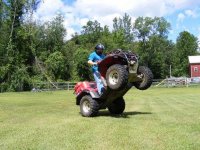Water Wetter can make a difference on thermostat controlled engines also.
The thermostat does open at a prescribed temp, but the thermostat does not control the maximum temps possible. Most thermostats once at the rated temp or near rated temp are fully open anf flowing at 100%.
Adding Water Wetter increases the efficency of the coolant, allowing the coolant to absorb heat more easily as it flows through the engine, and then disipate heat more readily through the radiators.
By doing this, the engine has a more uniform heat on all parts, plus the system is more efficient, and in extreme cases of ambient temps or heavy loads the engine runs cooler.
As for annual coolant replacement when using water wetter, that is partially true. The instructions for using Water Wetter allow variations of how the product is employed.
The best results for cooling and race track safety is to use a mix of only water and Water Wetter, that setup does not offer corrosion protection, and if on a race bike, the coolant is constantly drained.
When using Water Wetter to supplement anti freeze, there is still improved cooling, however, the system retains corrosion protection from the anti freeze, so the need for annual coolant replacement is not there.
I have never actually compared our RT idling beside another, but in theory, just like in my race bikes, at idle, you will more easily see the better cooling efficency. The race bikes no longer push coolant out the overflows, and on the RTs, I suspect our fans would cycle on less frequently, but maybe no.

